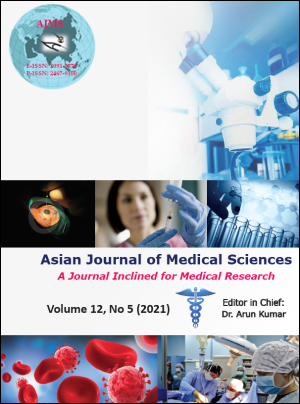A study on effect of phototherapy on platelet count in neonates with unconjugated hyperbilirubinemia: a hospital based prospective observational study
Keywords:
Thrombocytopenia, phototherapy, neonatal jaundiceAbstract
Background: Thrombocytopenia as a side effect of phototherapy has not been mentioned in standard literature and textbooks. Though there are few studies in this regard, but results are conflicting.
Aims and Objective: Hence, the present study is undertaken to find out whether any significant change in platelet count occurs following phototherapy, and if there be any, to see whether the changes are transient or not.
Materials and Methods: This prospective and observational study was carried out over a period of one and half years (1st March 2019 to 31st August 2020) on 190 new-borns admitted with idiopathic unconjugated hyperbilirubinemia needing phototherapy through consecutive enrolment. Serum bilirubin (total, conjugated and unconjugated) and platelet count were done before initiation and just after completion of phototherapy, and seven days after completion of phototherapy. Appropriate statistical tests were used to make statistical comparisons with a p-value of < 0.05 taken as significant.
Results: Among 190 neonates, 108(56.8%) were male and 82(43.2%) were female; 90(47.4%) were preterm and 100(52.6%) were term. Mean birth weight was (2.4725 ± 0.4782) kg. Mean gestational age was (36.4316 ± 2.4802) weeks. Mean haemoglobin level was (17.3816± 1.0784) gm/dl. Mean age at presentation was (4.5737± 1.5811) days. Mean total serum bilirubin (TSB) before initiation, after completion, and 7 days after completion of phototherapy were (17.8595 ± 3.7034) mg/dl, (8.1726 ± 2.2586) mg/dl and (5.7279± 1.5918) mg/dl respectively. The mean duration of phototherapy required was (48.1895 ± 13.6054) hours. Mean platelet count before initiation and just after completion of phototherapy were (2,49,321.0526± 89,460.2101)/μL and (2,22,436.8421 ± 88,538.7173)/μL respectively. Mean platelet count 7days after completion of phototherapy was (2,46,210.5263 ± 87,442.3038)/μL. Decrease in platelet count just after completion of phototherapy was statistically significant. Fifty-nine (31.1%) out of 190 neonates developed mild thrombocytopenia (100000- <150000/μL) just after completion of phototherapy, but none developed moderate or severe thrombocytopenia. None having thrombocytopenia manifested with clinical bleed. Platelet count raised near to pre-phototherapy level 7 days after completion of phototherapy. Fall in platelet count was found to have a positive association with increased duration of phototherapy and lower gestational age (p<0.0001). However, there was no statistically significant association (p>0.05) between reduction in platelet count with gender.
Conclusions: Though the incidence of thrombocytopenia following phototherapy was significant, but it was mostly mild and transient, and clinically insignificant. There was significant association between decrease of platelet count with duration of phototherapy and lower gestational age.
Downloads
Downloads
Published
How to Cite
Issue
Section
License
Authors who publish with this journal agree to the following terms:
- The journal holds copyright and publishes the work under a Creative Commons CC-BY-NC license that permits use, distribution and reprduction in any medium, provided the original work is properly cited and is not used for commercial purposes. The journal should be recognised as the original publisher of this work.
- Authors are able to enter into separate, additional contractual arrangements for the non-exclusive distribution of the journal's published version of the work (e.g., post it to an institutional repository or publish it in a book), with an acknowledgement of its initial publication in this journal.
- Authors are permitted and encouraged to post their work online (e.g., in institutional repositories or on their website) prior to and during the submission process, as it can lead to productive exchanges, as well as earlier and greater citation of published work (See The Effect of Open Access).




